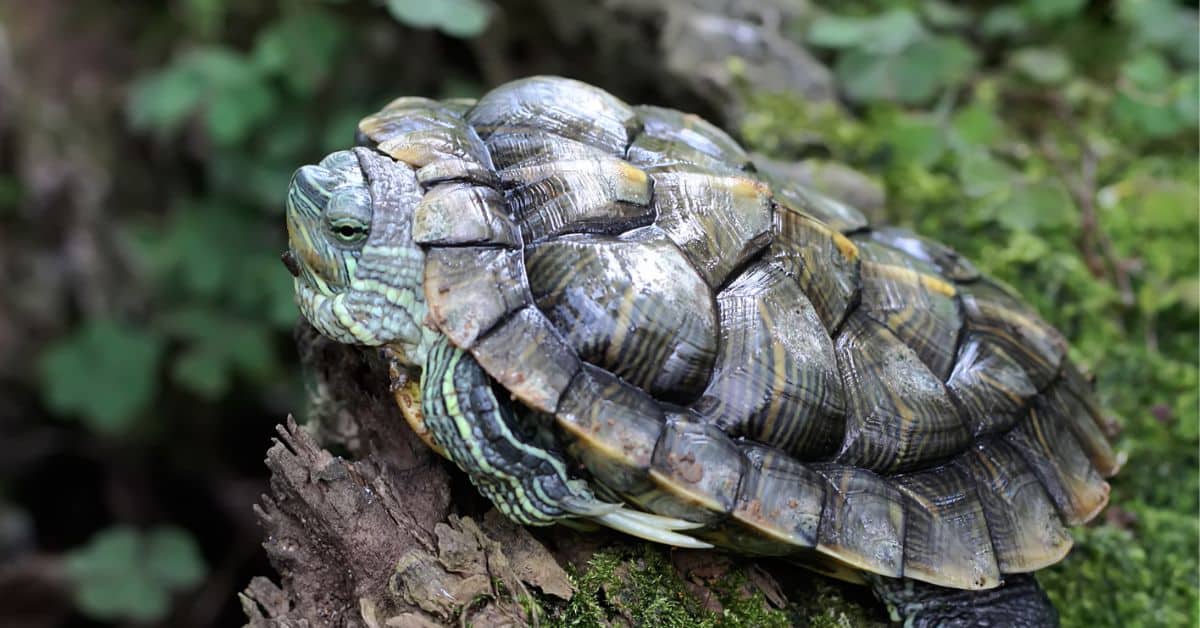What Is The White Film Over Turtles Eyes?

A white, cloudy film on a turtle’s eyes can be a sign of a bacterial infection. This type of infection can be dangerous if left untreated, as it can cause permanent damage to the turtle’s eyesight.
If you suspect that your turtle has a bacterial or fungal infection of the eyes, it’s critical to take it to a veterinarian ASAP. The vet will be able to diagnose the problem and provide appropriate treatment, which may include antibiotics or antifungal medications.
In the meantime, you can help keep the turtle’s eyes clean by gently wiping them with a warm, damp cloth. Do not use any solutions or chemicals on the eyes, as these can be very sensitive.
We dig a little deeper into (almost) everything you need to know about white film clouding a turtle’s eyes below!
Contents
What is the Film on My Turtle’s Eyes?
There are a few different things that could be referred to as a “film” on a turtle’s eyes, so it’s difficult to say without more information.
However, I’ll describe a few common possibilities and what they might mean for your turtle’s health:
- A white, cloudy film on the turtle’s eyes could be a sign of a bacterial infection. This should be treated by a veterinarian as soon as possible.
- A turtle’s eyes may also appear dull or have a film over them if they just aren’t getting plenty of vitamin A in their diet. Vitamin A is essential for healthy eyesight and a deficiency can cause a variety of eye problems.
- Some species of turtles naturally have a thin, clear protective layer on their eyes called a nictitating membrane. This membrane can be drawn across the eye to protect it from damage or to help the turtle see better underwater. If you’re unsure if it’s a membrane, you can try to gently touch it, if it moves across the eye, then it is probably the membrane.
- In some cases, a turtle’s eyes might appear to have a film over them if they are not getting enough light. Turtles need access to natural sunlight or UVB lighting to properly metabolize calcium and maintain overall health.
The white, cloudy film you notice on your turtle is the one you need to get out in front of ASAP. That kind of film isn’t anything to fool around with – it could cost your turtle their eyesight!
What Can Be Done to Prevent White Film on My Turtles Eyes?
There are a few things you can do to help prevent a white, cloudy film from developing on your turtle’s eyes:
- Provide appropriate lighting: Turtles need access to natural sunlight or UVB lighting in order to properly metabolize calcium and maintain overall health, which can help prevent eye infections.
- Provide a balanced diet: Feed your turtle enough Vitamin A, as a lack of this vitamin can make turtles more prone to eye infections. You can feed your turtle dark, leafy greens, carrots, and sweet potatoes, or consider using Vitamin A supplement under the guidance of your vet.
- Keep the enclosure clean: Regularly clean the turtle’s enclosure, making sure to remove any feces or uneaten food promptly, and doing a full cleaning of the enclosure and all the items in it.
- Proper water quality: Make sure the turtle has clean water, and change the water frequently. The water should also be dechlorinated, you can do this by letting it sit for a day before putting the turtle in.
- Monitor the turtle’s overall health: Observe your turtle regularly, and keep an eye out for any signals of illness or discomfort, such as lethargy, lack of appetite, or difficulty swimming.
By providing appropriate care and monitoring the turtle’s overall health, you can help to reduce the risk of eye infections and other health problems. Remember that a turtle is a long-term commitment and you need to be diligent in providing them with the best care possible.
FAQs
Does the white film come and go at different times of the day?
If the turtle is stressed, the film may appear and disappear. Stress can cause a release of hormones which can affect different parts of the body, including the eyes.
If you’re uncertain, it’s always best to consult a veterinarian and have the turtle checked out. They can help you identify the problem and recommend appropriate treatment, if necessary.
What should I do if the white film keeps coming back?
Talk to a veterinarian: If the white film keeps coming back, take your turtle to the vet for an examination. The vet will be able to diagnose the problem and recommend the appropriate treatment. The vet might perform a culture, or might take a sample of the film for analysis, or confirm an infection.
It’s important to address the issue as soon as possible to prevent any long-term damage or complications. If the vet prescribed any medications, follow the instructions carefully.
Can this film show up in different colors?
While a white, cloudy film is the most common type of film that appears on a turtle’s eyes, there are other colors of film that can appear as well.
- Yellow film: A yellow film on a turtle’s eye can be a sign of a bacterial infection or an accumulation of pus. If the yellow film is accompanied by redness, swelling, or discharge, it’s important to take the turtle to a veterinarian as soon as possible.
- Green film: A green film on a turtle’s eye can also be a sign of a bacterial infection. Green pus is often caused by Pseudomonas aeruginosa, which is a type of bacteria that is common in turtles.
- Red film: A red film on a turtle’s eye can be a sign of inflammation or irritation. This could be caused by a number of factors such as poor water quality, trauma, or exposure to irritants.
- Black film: A black film on a turtle’s eye can be a sign of melanoma, a type of skin cancer. Melanomas can occur in many different parts of the body, including the eyes. They are usually benign, but it’s important to have them checked by a vet to be sure.
What should I do if the film shows up on my turtle’s ears, nose, or mouth?
There are a variety of different causes behind film on a turtle’s ears, nose, or mouth. Some of the root causes include:
- Infections: A film on the turtle’s ears, nose, or mouth could be a sign of a bacterial or fungal infection. These infections can occur as a result of poor water quality or a compromised immune system.
- Respiratory Infections: A film in the nasal area or around the mouth can be a symptom of a respiratory infection, such as pneumonia or mycoplasmosis. Respiratory infections can be caused by a variety of factors, including poor water quality, exposure to cold temperatures, or stress.
- Skin mites: Turtles can get infested with mites, small parasites that can cause irritation and itching, leading to excessive scratching, and film development on the affected area.
- Allergies: Some turtles can develop allergies to certain substances in their environment, such as food, bedding, or cleaning products, and this can cause film on the ears, nose, or mouth.
- Trauma: An injury or trauma to the turtle’s ears, nose, or mouth can also lead to the formation of film as the turtle’s body tries to heal the wound.
- Nutritional deficiency: A deficiency in certain nutrients, such as Vitamin A, can lead to a variety of health problems, including the development of film on the ears, nose, or mouth.
If you see any signs of film or mucous building up on your turtle – their eyes, their ears, their nose or their mouth – you need to call the vet ASAP.
Don’t delay, these are health issues that have to be cleared up straight away.




